#National World War I Museum and Memorial
Explore tagged Tumblr posts
Text
REVIEW: Jackson County Historical Society - Young Historian Passport Program [History Tour]
A Youth Program Sponsored by the Jackson County Historical Society in Missouri In 2022, my son and I jumped onto the opportunity of being in the first handful of participants of the Jackson County Historical Society Young Historians program. As an educational program, it’s a cool idea. With museums always wanting more participation, and most children’s tendency to love “gamifying” things and…

View On WordPress
#children&039;s activities#education#educational#Historical#Historical House#Historical Site#History#History Boy Summer#History Tour#Independence#Independence Mo#Jackson County#kansas city#Kansas City Missouri#KCMO#missouri#museum#Museum Trips#Museums#National World War I Museum and Memorial
0 notes
Photo
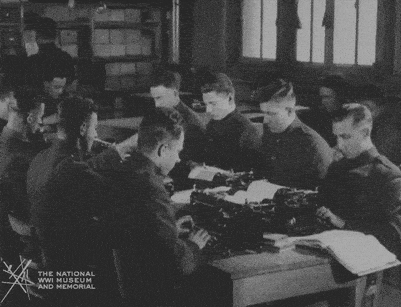
(via GIPHY)
#giphy#happy administrative day#happy secretary day#black and white#working#military#typing#footage#soldiers#uniform#typewriter#historic#wwi#secretary#national archives#world war i#great war#first world war#national wwi museum and memorial#at work#doughboy#american soldier
20 notes
·
View notes
Text
Maybe this is a 'water is wet' statement, but: putting the Holocaust on a pedestal where it can never be compared to anything else doesn't just serve zionism, it serves the individual agendas of a lot of colonialist powers too because it ensures that their history of atrocities is never compared to the Holocaust and remembered in the way that our culture remembers the Holocaust.
The transatlantic slave trade? The deliberate British Great hunger in Ireland? The deliberate British Famines in India? The Holodomor? The multiple acts of ethnic cleansing and mass murders committed by the Netherlands in Indonesia and its other colonies? Leopold II's reign of terror in Congo? And countless others.
All of these exist in the relatively ignored field of 'lesser evils' and aren't remembered and used as national moral anchors in the way the Holocaust is. They're not at the center of our collective memory because this one great horror takes center stage and it is deemed morally unacceptable to place other horrors near it. The only exception I can think of is the US, where thanks to the endless hard work of African Americans, slavery is sort of kinda almost recognized in the collective consciousness as a second great horror. But it's still second fiddle and disputed, and meanwhile in the European countries that engineered the transatlantic slave trade and profited from it, the space it takes in the collective consciousness is tiny.
The Netherlands has over 70 World War 2 museums. It is yet to open its first museum about slavery and has no museums dedicated to it's other colonial atrocities. The budget of the national World War 2 commemoration is 35 times larger than that of the national slavery commemoration. Holocaust education is important, but something is out of whack here. And it's easy to see why colonial powers don't want to change that.
285 notes
·
View notes
Text
Hello MotA and other WWII fandoms (based on real people or not)! I have a fun piece of history for you that you may or may not be aware of.
I just finished my last day working at a pretty cool place. It's a branch of the public library in Albuquerque, New Mexico, U.S.A. What does this have to do with WWII? Let me tell you!
I just so happened to work at the Ernie Pyle branch, named so because it was the only house that the WWII war correspondent Ernie Pyle and his wife Jerry ever owned. Ernie Pyle, if you have never heard of him:
went overseas with the soldiers to document the second world war
pioneered human-interest style journalism for war reporting, specifically focusing on the lives of the soldiers and conditions on the front lines
wrote MANY MANY articles about the soldiers and their daily lives
won some awards, including a Pulitzer Prize
and was killed in action in Japan in 1945, at the age of 44
Here he is, looking a lot more serious than a lot of the pictures of him in his home, as well as a shot of him, his wife, and their dog, named Cheetah:
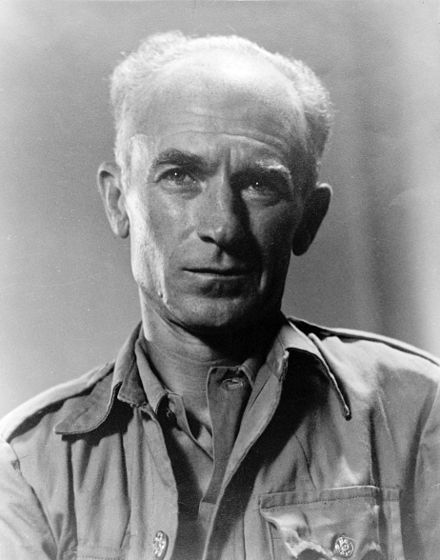

And, if you've never seen it, the house-turned-library looks like this:

The Indiana University has a few of his articles free to read, so check those out if you want to get an idea of the kind of journalism I'm talking about here: https://erniepyle.iu.edu/wartime-columns/index.html
For the MotA fans specifically, one cool fact about Ernie Pyle is that he had not one, but TWO separate B-29 "superfortresses" named after him. One was just called the Ernie Pyle, while the other was called Ernie Pyle's Milk Wagon (in reference to a quote of his calling the bombings of Japan "milk runs"). The library has a picture of the Ernie Pyle up on top of one of the windows:


And here it is in flight:

So, why a library? Why not, say, a museum? Well, there IS a museum--in his hometown of Dana, Indiana. After his death in 1945, and before his wife's passing that same year, Jerry Pyle (said wife) decided to give their house to the City of Albuquerque in order to honor his memory. There was a lot of back and forth, but one thing stood out above all else: Ernie was a private guy, and this was his home. According to an interview he once gave, he'd said that he built a house because he "needed a place to store his books"--and so what better way to commemorate his work than to fill his house with books?
The house was built in 1940, and as a library it has been in near-continuous use since 1948. It's now a national historic landmark, as well, and celebrates National Ernie Pyle Day every year. It is the second oldest library of the Albuquerque Bernalillo County Library System--the oldest being our Special Collections library--which makes it the very first satellite of the ABQ library system. The ABQ library system now boasts 19 locations. The Ernie Pyle branch is, still, the smallest.
It also has an Ernie Pyle G.I.Joe action figure on display, which is clearly the most important thing to note here:
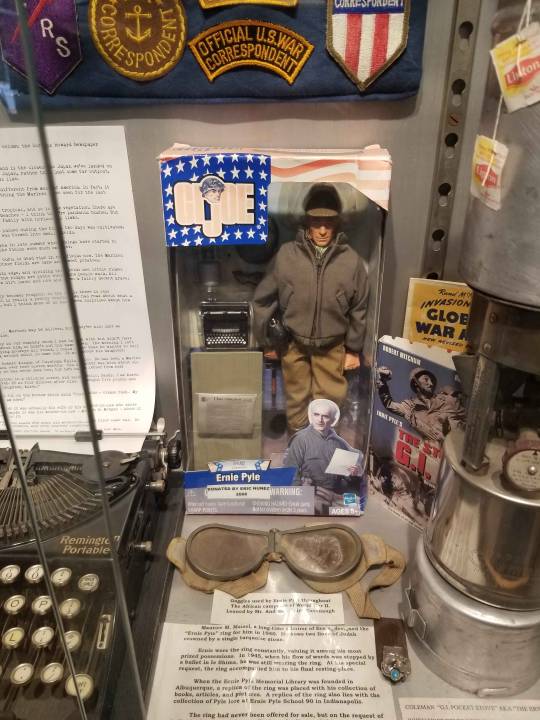
I don't know how Ernie would feel about the fact that people come from all over the country to visit his home, but at just over 1000 square feet, it's the coziest library I've ever been in. I think it's really neat how history ties us together, and it seems pretty profound to me that Ernie Pyle was so dedicated to immortalizing the men who risked life and limb to fight a war that spanned the entire globe.

Not to mention the fact that I got to put up a lot of staff picks and displays, which was hella fun. Here I am with Moby Dyke and Chainsaw Man (top) and some pictures of one of my favorite silly displays (bottom):

(when is the best time to come out of the closet? ...when the coast is queer!)
I also got to make our holiday card this year! So, to all you WWII nerds, fandom or otherwise...

#ernie pyle#the ernie pyle library#WWII#journalism#mota#masters of the air#my art#my face#lol#hi#albuquerque#new mexico#not doxxing myself because i do not work there anymore#but hey y'all should still go it you ever get a chance!
25 notes
·
View notes
Text
Daily update post:
You might have seen me mentioning before the Palestinian Authority's "Pay for Slay" policy, where they pay Palestinian terrorists based on how deadly their attacks have been. Let me share something even worse: based on the Oslo peace accords from the 1990's, Israel collects the Palestinian tax money, and then passes it along to the PA. Which means, when Israel became aware of the "Pay for Slay" law (yes, turns out that it's a LAW, not just a program, that the Palestinian Authority pays terrorists... the same PA that now has the audacity to claim at the International court in Hague that Israel is committing a genocide, meaning the intentional destruction of, or a part of, a nation... I think a LAW that financially incentivizes terrorists to kill members of the Israeli nation fits), it also realized that Israeli authorities, paying with Israeli tax payer money for the work done by Israeli clerks tasked with doing this, has been collecting and passing along money that goes to pay Palestinian terrorists for having attacked, injured and murdered Israelis. In what world is that right? In what world is it moral to make a victim, through a "peace accord" participate in the payment to its victimizer? As part of the money collected by Israel and given to the PA, an annual 278 million dollars (!) are then passed by it to Palestinian terrorists for hurting and killing Israelis. The PA has already added Oct 7 terrorists, most of them Hamas members, to the list of those being paid thanks to the "Pay for Slay" law.
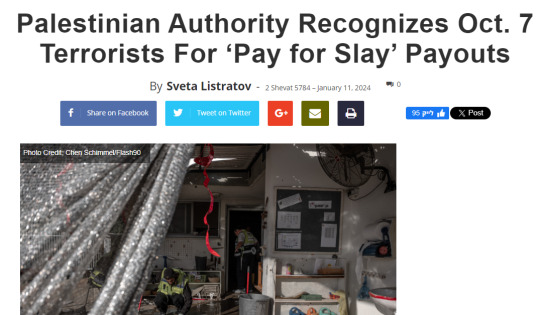
The annual payment was revealed thanks to a lawsuit by the parents of 26 years old Dalia Lemkus, who was stabbed to death in Nov 2014 by a Palestinian terrorist (he also injured 2 others. Dalia herself had survived a previous terrorist attack in 2006. On the day she was murdered, another Israeli was killed in a separate terrorist attack. I don't think most people realize just how intense Palestinian terrorism is). The lawsuit was filed against the PA, which has been paying him 3,300 dollars a month. This is Dalia, may her memory be a blessing:

I'm not gonna lie, I'm thinking about the fact that coincidentally, I've been at our Holocaust museum and education center since Nov 2014, with the purpose of helping to educate against antisemitism, racism, homophobia, every other type of generalized hatred that humans are capable of, and against genocide, which is the possible consequence of that type of hate. And a part of what's wrong with this world, is that even with me being a "veteran," I get paid less money a month than that Palestinian terrorist does for having murdered a Jewish woman based on that kind of generalized hatred. My income depends on how many tours, lectures or workshops I did that month, but in almost 10 years of working there, I have never had a month where I got a salary of 3,300 dollars, most months I don't make it to half of that, and I have had many months where my salary was zero (during Covid, and whenever the security situation is bad enough that no one comes to our museum). Don't get me wrong, I consciously made a choice to do this work, where my salary would be very low, because I wanted to do something meaningful, I'm not complaining, but I can't help thinking about the fact that a part of why antisemitism thrives, is because it IS socially and financially rewarded, clearly more so than fighting it. That was true before and during the Holocaust, and sadly has been true since as well.
I would love to understand how the evacuation of civilian Gazans out of the war zone is described as "ethnic cleansing" or worse, but not the evacuation of Ukrainian civilians out of those war zones, and not the evacuation of a Hamas-affiliated Al Jazeera "journalist" (who documented himself in southern Israel during Hamas' massacre), taken out of Gaza to Egypt, to be flown from there to Qatar, one of the two great financiers of Hamas (along with Iran). Qatar has not opened up its gates to wounded Gazan civilians. It's clear Ismail Abu Omar was given this special treatment precisely because he is a Hamas terrorist. What's scary about this possibility is that the IDF didn't know he was smuggled out of Gaza, begging the question, who else is Hamas smuggling out? Also, this is Hamas' middle finger to anyone claiming Gaza is closed off, and an open air prison or concentration camp...

Speaking of Qatar, it is currently hosting the swimming world championship. Israeli swimmer Anastasia Gorbenko won a silver medal, a huge Israeli achievement, but she got repeatedly booed by the crowd, including during the medals ceremony. Anastasia has a childhood classmate who is currently held hostage in Gaza. She dedicated her medal to him.
youtube
A TV report by an Israeli journalist (source in Hebrew) is about a Hamas document dated May 2023, which the IDF found, the summary of a Hamas leaders meeting. It details some of the considerations for the timing of "the big project," listing 4 Jewish holidays as possibilities for the massacre (including Yom Kippur, the holiest day in the Jewish year, and Simchat Torah, when the massacre actually took place), so it's clear Hamas was always going to use our holy days against us. Another thing mentioned is that Hamas must strike before Israel deploys Magen Or (literally: shield of light, but most publications in English refer to it as Iron Beam), the laser-based defense system meant to complement Iron Dome. The system has been making a lot of progress, enough that by Oct 2023 there have been reports on it becoming operational soon. The document mentions making Israel used to Hamas conducting large scale exercises close to the border, so that the commotion ahead of the massacre wouldn't look abnormal, and it also mentions making use of Palestinian Islamic Jihad, the second biggest Palestinian terrorist organization in Gaza. It wasn't included in the plans, but was being relied on. In recent years, all of Israel's operations in Gaza have been against PIJ, and Hamas chose not to join them, the document indicates that this was done in order to reinforce the idea in Israel that Hamas is more interested in the wellfare of Gazans, than in killing Israelis. At the same time, the document warns not to let PIJ fuck up Hamas' planned operation.
I did not write about the private initiative of family members to send medications through international mediators to Hamas, meant for the hostages, for the simple reason that I did not for a second believe Hamas would give the hostages these meds. I didn't wanna get my hopes up, when logically, I was sure such initiatives were futile. Now, thanks to the IDF's operation in the Nasser hospital in Khan Younis, we have confirmation that these meds were found in its pharmacy, with the names of the hostages on the unopened boxes, meaning the kidnapped Israelis never got them. We can assume the meds were kept in the hospital pharmacy, either to serve Hamas terrorists, or to be sold, with the money going to Hamas.

This is Matan ben Ari, the last Israeli injured on Oct 7 (out of thousands) to be discharged from the hospital on Dec 1, almost two full months after Hamas' massacre. People spontaneously gathered around to applaud him as he was making his way out:
youtube
(for all of my updates and ask replies regarding Israel, click here)
#israel#antisemitism#israeli#israel news#israel under attack#israel under fire#terrorism#anti terrorism#hamas#antisemitic#antisemites#jews#jew#judaism#jumblr#frumblr#jewish#israelunderattack#resources
123 notes
·
View notes
Note
its so comforting to see someone unbashedly love their country and culture. the way u write and speak of it its so refreshing to me. im from india and well, the state of our country isnt good our fascist leader is successfully dividing the people and its so rare these days to find ppl just simply love where they come from, culture and language without any hate for anyone else. so i absolutely adore it when i see u talk abt armenia its like one can see how much care u hold for the language and the country. wishing for peace and sending love x
I am sorry, dear, that dark clouds are looming over your bright and colorful land of magic. In my lifetime, I’ve had the pleasure of encountering a few young Indian people (both in real life and online), and I have a lot of love and respect for your nation and its culture. I am sure that brighter days are awaiting both our homelands.
You see, what I’ve noticed is that some people often confuse their fatherland with their government. The hatred that they have toward the latter often taints the love and respect they ought to have toward their homeland. But, once and for all, we must remember that these two are not synonymous. Fatherland is a place where the roots of history, culture and identity intertwine. A fatherland is not just a geographical location; it is a sanctuary of shared memories, values and traditions passed down through generations. It represents the collective spirit of a people, their history, struggles and triumphs. To call a place one's fatherland is to cherish it as a cradle of life, as one’s own home.
To me, the love one has for their fatherland is like a mathematical function that always moves towards infinity (its designated final value) but never quite reaches it. One can never love their fatherland enough. There’s always something more you can do, there’s always something better you can do. I guess the vessel that carries one’s love toward their homeland is only ever fully filled when one gives up their life to protect their fatherland.
I can only speak from my own experience – I was raised historically and, more or less, politically conscious. When you’re a six or seven-year-old impressionable kid and you visit The Museum of The Armenian Genocide of 1915, you see the photographs, the articles, all the documentation that exists – firstly, you’ll never be the same again, and secondly, your naïve childish brain thinks that, as you’ve always been told, whenever someone commits a crime or does something bad, they get punished. Then I looked around and noticed that these heinous crimes, these massacres, were not only left unpunished, but the whole thing was swept under the rug by the world, as if it never happened. Then you grow up, sharing borders with the enemy, the dagger of war swaying upon your head, with every new day bringing more and more deaths of Armenian soldiers serving on the border. You see your enemy disrespecting you, your history and your culture. You see them erasing your history and your culture … and all of this is accompanied by the crickets of the world. Then there’s Western Armenia calling for us, a topic that I plan on writing more about. And at last, our Ararat that you can see so very clearly from Armenia …
And, alongside this, there’s this immense pride you feel in being an heir to a nation that created a culture so distinctly beautiful, a nation that gave birth to luminaries such as Grigor Narekaci, Sayat-Nova, Hovhannes Toumnyan, Vahan Teryan, Eghishe Charenc, Daniel Varujan, Paruyr Sevak, Misak Metsarenc, Silva Kaputikyan, Hovhannes Grigoryan, Vardges Petrosyan, Martiros Saryan, Sergey Parajanov, Shahan Nathalie, Gurgen Yanikyan, Monte Melqonyan, and the list goes on … the nation that invented color television, ATMs, hand-held hair dryers, coffee machines, PET scans, MRI and so much more.
Have all of this brew in your soul and dare not to love and cherish your fatherland – you can’t.
52 notes
·
View notes
Text
Nyotalia fanfiction
I'm not sure if my memory is right but I remember there being this long fanfic on fanfiction.net about the nyotalia nations existing in the same world as the normal hetalia nations, but neither of them knew each other was a country. I think it was called "Women of the World" and there was a pending rewrite of it at one point, but I'm pretty sure both are deleted now.
Please tell me I'm not imagining things, and if anyone has a link or a copy of it.
I think the first chapter started with Nyo China, and her perspective on her interactions with the Chinese people. I started reading it sometime during or after 2016, but it could have been published before then.
Other scenes I remember were Nyo England being a pirate and kidnapping Hetalia England onboard a ship he was on and calling him Sir Pansy. During that arc I think she was called Rosa Kirkland.
During the American Revolution, Nyo America was shooting a gun and had a conversation with Hetalia America about how she was firing it. When the war was over she went to visit Nyo England at her house in the Americas and England ran out to her saying she was so proud of her.
Nyo Lithuania was a knight of sorts and she competed in order to become the bodyguard for Nyo Poland. During her fight, her sword broke and she let out a string of curse words, one of which was the word walnut.
Nyo Switzerland had a shop that she owned and moved around every so often to prevent others from realizing she was immortal. Nyo Austria was a frequent customer and when she realized how long Switzerland has owned the shop she figured out she was a fellow nation.
The Nyo Nordics were looking for their Iceland and Denmark decided to make a scene and announce to the people that they were going to build a museum of dicks. Norway was the one who noticed Iceland was trying not to look at them.
Nyo Russia snuck into a world meeting by pretending to be a server and met Nyo China who was hiding inside the food cart. Russia took China back to her home to add her to her family and when they were eating dinner she scolded Latvia for forgetting her manners and told her to sit up straight. Nyo Lithuania helped China sneak out the next day.
Nyo France and Canada went to visit Nyo England and America one day, and they all noticed America was growing faster than usual.
Nyo Japan was with China at one point in order to help her rebind her feet because they kept healing every time she took her shoes off to clean her feet.
Hetalia Japan was in the middle of taking over a town and got into a fight with Nyo Japan who was defending a house. Nyo Japan lost to him, but put up a good fight.
Nyo Finland was living in a town that was targeted for an attack and she went on a rampage, eventually having a breakdown but was found by Nyo Sweden who helped her recover.
#hetalia#nyotalia#hetalia fanfiction#aph hetalia#deleted fanfiction#not art#not writing#fanfiction#fanfiction.net#nyotalia fanfiction
8 notes
·
View notes
Text
LISBON—Maria Brites took one more carnation in her hands from a table covered in them. She carefully set the flower in a glass box. Brites, an accomplished 76-year-old art teacher, has made dozens of these graceful souvenirs for Portugal’s museums to preserve the memory of the so-called “Carnation Revolution” which changed her own and her country’s life. It was April in Lisbon and outside, tourists teemed through the streets in the capital of a liberal democracy ranked among the freest nations in the world. Joined by her two adult daughters, Maria began to sing “Grândola, Vila Morena.” Fifty years ago, the fascist regime installed by Antonio de Oliveira Salazar banned other songs by its author, Zeca Afonso, for his opposition to the dictatorial regime. On April 25, 1974, conspirators played “Gradola Vila Morena” on the radio at 12:20 a.m. The song’s powerful melody and lyrics signaled the beginning of the revolution.
“Land of brotherhood,” the lyrics exclaim, “the people are the ones who rule within you, oh city!”
Exactly half a century later, hundreds of thousands of Portuguese gathered in Lisbon to chant “No to fascism.” Banners strung throughout the city featured happy people hugging with the caption, “Europe is for you.” According to the Migrant Integration Policy Index, Portugal has the second-most favorable citizenship regime in the European Union, in terms of naturalization rates.
Over this period, Portugal has not just shed its dictatorial past, it has become a leader of multilateral democracy. Think of the EU’s Treaty of Lisbon, which helped to manage the bloc after it enlarged from 15 to 27 states, as well as Portuguese native António Guterres ascending to secretary-general of the United Nations in 2017. This spring, an absolute majority of Portuguese—81 percent—told pollsters that they were proud of the way that Portugal became a democracy. This process involved not just ending its dictatorship at home, but also liberating its remaining colonies in Africa.
When I visit Portugal and observe this pride in action, my mind inevitably goes to post-Soviet countries that failed to keep their liberal democracies and rolled back to dictatorial regimes in the decades after the fall of USSR. During my 24 years of covering news in the region, I interviewed many people in Russia, Belarus, the Caucasus, and Central Asia who told me they felt nostalgic for a strong leader like Joseph Stalin. It seemed to me as if they were suffering from the loss of historical memory. Russia targets leaders of the Nobel Peace Prize-winning group Memorial that worked hard to preserve painful memories, documenting hundreds of thousands of KGB cases and gulag victims, including the names of 44,000 people executed on personal order of Stalin. But the Portuguese do not hide their history, nor do they miss Salazar. Why? As millions of Ukrainians suffer from a war spurred on by Russia’s imperial ideology, I wanted to find out.
Since the beginning of Russia’s war in 2022, more than 60,000 Ukrainians have found refuge in Portugal. To the amazement of many of them, banners and billboards celebrating the country’s anniversary still feature communist hammers and sickles. Some slogans by the Portuguese Communist Party (PCP), including “Mais forca!” are confronting to people from the former Soviet Union. The symbolism carries a valence that is hard to reconcile for them, and the associated iconography cuts against the message of freedom. In occupied Ukraine, these symbols signal the return of the authoritarian era, but in Portugal, communists helped end it.
The PCP was founded in 1921 as a legal party, but in 1926 it was forced underground by the far-right Estado Novo regime. Salazar came to power in 1932 and continued severe repression of anarchists and communists. Lisbon’s former prison, Museu do Aljube, lists the names and photographs of Portuguese opposition members imprisoned, tortured, or executed by the regime in the 1930s. The underground did not stop its struggle for over four decades of Europe’s longest dictatorship, though, and the working class and communist underground played a decisive role in preparing for April 25.
Portuguese communists, whom Moscow denied paying, were widely celebrated for the Carnation Revolution’s victory. Their involvement meant as soon as the people of Portugal embraced freedom from the dictatorship, they had to choose a side in the ongoing Cold War. The same year of the revolution, 1974, Soviet leader Leonid Brezhnev visited Fidel Castro in Cuba. Brezhnev was pushing European governments, the United States, and Canada to sign a document about security in Europe, recognizing the Soviet military victory in World War II, the acceptance of Soviet domination in Eastern Europe, and forced incorporation of Baltic states.
Fortunately for Portugal, the United States played a cautious role in Portuguese internal affairs, while the Soviet Union accepted the choice Portuguese people ultimately made to embrace the democratic path. “By the fall of 1974, communists tried to take over the power but our people made a different choice—we chose democracy,” Brites said.
Portugal signed the Helsinki Accords, along with nearly all other European governments, Canada, the United States, and the Soviet Union in Helsinki on Aug. 1, 1975, confirming the acceptance of post-1945 borders. Later pro-Soviet regimes took power in Portuguese former colonies in Africa, including Angola. After the revolution, Portugal gave independence to Angola, a colony for nearly 500 years (and a source of slaves for Brazil), withdrawing its military forces by November 1975.
On a recent afternoon, I talked about liberal values with immigration lawyer Gilda Pereira, who grew up in Angola where her family enjoyed a wealthy and successful life before the revolution. Portugal’s presence in Angola began with the arrival of the explorer Diogo Cão in 1482, and although Portugal officially changed Angola’s status from a colony to an oversea province in 1951, its landlords continued to use forced labor at local plantations.
I expected somebody who grew up affluent in a former colony might be less in favor of the changes in Portugal but Pereira’s face was illuminated with a big smile when she talked about the revolution and how it transformed her country. The founder of a successful law firm in Lisbon who employs more than a dozen women lawyers, Pereira said she felt “zero nostalgia” for the dictatorship and loved Portugal’s active civil society and its passion for freedom. Portuguese human rights defenders are respected, she said, and investigative journalists are acclaimed.
“I am glad we let Angola and other colonies free, I am happy we have the rule of law, that we are true democrats,” she told me. Under Salazar, Pereira explained, she and her team of women would lack basic human rights. Progress continues, and this year, Portugal has risen to 17th in the Global Gender Gap Index ranking of equality, up from last year’s 32nd place.
Local freelance reporter Claudia Maques Santos explains Portugal’s choice this way: “I think it has to do with memory and sense of freedom.” For many Portuguese, recalling the era of authoritarian rule is far more painful than it is aggrandizing. Maria Brites echoed this, telling me she was “utterly unhappy” under Salazar and his successor in the provincial town where she taught art and raised her daughters. The dictatorship forbade divorce, and hers was a miserable marriage: “Every month he picked up my salary at school,” she said of her husband, “as all men were allowed to do that to women. We had no rights.”
On the morning of April 25, 1974, Brites’s father called to tell her that the revolution had happened, and she rushed to Lisbon to see it for herself, even though, she said, her husband tried to stop her with threats. Arriving in Lisbon, she felt what she described as “complete happiness, freedom to say what you felt like.”
Improbably for a democratic revolution, Portugal’s transition began with a coup, as military officers who opposed the regime rose up against it, in no small part because of the country’s imperial adventures abroad. Under Salazar, Portugal was paying an immense human cost fighting to maintain its African colonies. Over lunch in April, Col. Aprigio Ramalho, one of the officers who led the revolution, told me that the trips he made to Mozambique and Angola under the dictatorship were part of what galvanized his action. Portugal had waged war in Africa for 13 years, and thousands of Portuguese men had died there. “The failing African wars were the turning point for the revolution,” the colonel told me. The analogy to Ukraine was not lost on him: “Russian military men should read their oath well. We did. We were sworn to defend the people, or Portugal, our country, but not the dictatorship.”
Isabel Graca, a history professor at Almada Senior University, told me, “We made the choice to be free: No woman under Salazar could travel abroad without her husband’s permission. … As a student, I ran away from the police many times. We were banned from gathering in groups of more than three people. Punishment was severe.”
For women in particular, the civil liberties they could not have under dictatorship were far more critical than the distant territories that fascist Portugal claimed to control. This is exactly the situation citizens face in today’s Russia, where millions of people suffer from poverty, domestic violence, corruption, and a poor health system and where none of Putin’s imperialistic ideas and promises to build the “new world order” together with China and Hungary can distract from daily miseries.
Once again Portugal has chosen a side in a cold war. More than 70 percent of Portuguese have a negative view of Russia’s influence in global affairs, according to a German Marshal Fund report, and roughly 80 percent want to offer Ukraine NATO and European Union membership. Even PCP—which was the sole political party avoiding condemnation of Russia for starting the full-scale invasion in 2022—has chosen democratic values, not dictatorship. In its latest platform, the party advocates for Portugal to enjoy “a regime of freedom where the people decide their own future.”
Pedro Magalhaes, a senior researcher at Portugal’s Institute of Social Sciences, told me that Portugal has little reason to worry about the role of communists in its political life. On the contrary, he said, “Communists have been reliable democratic actors, involved in revising the constitution, controlling law-abiding unions, and having representatives in parliament.”
This year, Portugal’s far-right party Chega won 48 seats in the parliament. They have been accused of racism: In 2020, the party’s founder, André Ventura, was fined for discriminating of Roma community. That same year, he wrote on social media that Black lawmaker Joacine Katar Moreira should go back “to her own country.” But local democrats are not worried. “Chega is being left alone at the parliament, no one makes alliances with them, neither left- nor right-wing parties,” Marques Santos told me.
Nearly half of Portugal’s population earn less than 1,000 euros a month, many complain about their country quietly becoming an immigration hub, majority want a reduction of emigration. But in spite of the social issues, Portugal continues to resist to the extreme far-right agenda. June poll showed Chega getting 12 percent of support, which was a drop from 18 percent it received in the election.
“Portuguese people have a genuine love for freedom,” Magalhaes said.
14 notes
·
View notes
Text
REVIEW: National WWI Museum – Entertaining the Troops [History Tour]
A Museum Exhibit Usually the National World War I Museum in Kansas City, MO has a big marquee exhibit about every eight months or so, but people have a tendency to overlook some of the smaller exhibits upstairs, in this case in one of the two buildings next to the Liberty Memorial itself. I am actually late to see their new BIG Exhibit, “Bespoke Bodies“, but I figured I’d talk about…

View On WordPress
#day trip#Historical#History Boy Summer#History Tour#kansas city#KC#museum#National World War I Museum and Memorial#World War I#WWI
0 notes
Text
Ahkmenrah x fem! reader "Heimat"
I'm incredibly bored and watched some Night at the museum. Than it just happened that I thought a little bit (is indeed a rare process) and well I thought I could write a little oneshot for the pretty pharao. I couldn't help myself soo yeah. Btw the reader is in this oneshot from the time of the 20th century and to be more specific (is it written that way? idk well if not I am counting on all of you that you're going to tell me if it's right or not) the reader is from the time of the second world war and well there may be some topics that can trigger people. So I will put a trigger warning at the beginning. But well maybe not I'm not sure what I will include and so on and I also don't know how I make the reader so yeah... I will just go with the flow and write for my hearts content (not sure if I can put it that way). So before the beginning I write a quick definition for the word "Heimat". Ouhh and my little to long author notes are those little mini textes.
Heimat (german): "a place, where someone was born and grew up or is there long enough to have a feeling of being at home (is mostly a word for a place (and sometimes someone) that (or who) someone has a very special connection to)
translated out of the "Duden" can't say it's the right translation to the definition but well if someone of you has a better definition that's in english I'll gladly swap that with this one if you don't mind.
Well let's go then! ahh... btw I write about a female reader so yeah... if you want another one with gender neutral or a male reader ask right away and then I'll write it as soon as I can! I am not a native speaker so well it certainly has some errors and I'll correct them if you tell me where some are. Thanks and let's go!
TW: mentions of the holocaust, death, national socialists and some of the other stuff about the 2nd ww and also swearing but only lightly and once if I'm not mistaken
You have been warned. Reading on your own... I forgot the word. Eh... something like concequences ig but I'm not sure. It's way to late for writing tbh. And if you don't want to read the stuff with the 2nd ww then just skip the background. I will mark it for you guys.
- - - - - - - - - - - - - - - - - - - - - - - - - - - - - - - - - - - - - - - - - - - - - - - -

Everyday I remember my cruel death. I am nothing but a little wax figurine that just resembles my once very much alive self but I still have her memorys. Even though I am only made out of wax and don't even have a real brain. She was a hero for a lot of people even though she was only a little artist that wasn't much known. She lived in nazi germany so she knew what was going on in germany. Even more because one of her friends worked for the terrifying camps. He told her a lot of things proudly and most of them weren't allowed to be told to zivilian people like herself. She took advantage of the knowledge and used it for her art. She showed the terrors of the war of the holocaust of everything.
She also started to try to change the world for the better and so she came into the view of the regime and their corrupted forces. She was able to trick them but well her luck ran out after she helped a spy of the united states. The spy learned a lot of things from her that were cultural differences between the two countries. With her help he was able to keep hidden. To his luck he looked also like a "typical german" probably had ancestors that were german people. However that was a reason why spys of the allies were basically searching for her so that she can also help them. She was bad at denying the need for help of other people. The spys that resided in her humble home also found out that she hid two jewish families in her house.
Europe and germany were her so called "Heimat" she looked up to Stefan Zweig who also saw europe as his "Heimat" or his home. But well his works were forbidden in germany thanks to the national socialists. She was enraged to find out that her favourite author isn't allowed in her home. But she couldn't give a single shit. She still had the books of him that she once bought. She hid them well. They always tried to find something so that they could arrest and torture her. Well she wasn't allowed to draw anymore and that was a problem but she never stopped with helping others out.
Then someday one of her neighbours told her off to the ss. They came into her home and found everything the spy who resided with the young woman and also the jewish families, the forbidden books and her forbidden art studio. Also the books of different languages such as english, french, japanese, italian, spanish and much more. She learned them all and can speak some of them fluently while the others were a little rusty but good enough to communicate decently. They caught her and they also punished her. And their punishment was the reason for her death. She was a strong woman who helped as much people as she could by sending them off to other countries or hiding them and teaching them. The spy was also tortured and died right next her when a bomb of the english army fell onto the building they were in. He apologized to her but she told him that it wasn't his fault and that she decided for herself to walk on this path that was hidden in the darkness without any sight of light. She wanted to bring light into her home, her "Heimat". But she lost it and she pobably never gets it back. Well that's what her dying self thought but that wasn't exactly true.
~End of backstory~
She came back to life and well she is now my humble self who is a good friend of hystorical people like Sacagawea, Theodore Roosevelt and others. My personal favourite of them all is Ahkmenrah. He is a pharao of egypt who is dead like most of us. Makes sense right? And well he kind of is more to me. I certainly don't know what I am for him but he is more than a friend. I think it's enough to say that I have kind of a crush on the handsome egyptian man. Well okay it's a big crush to be honest.
Everytime when I have those nightmares about my death he's there to help me. I'm very thankful to have him. Even though I'm quite sad that I don't know about his feelings for me.
Well my little thoughts about my past and current situation were interrupted by hand that waved in front of my face. I blinked twice and mumbled a little "Wa?", that made him chuckle. "You were very deep into your thoughts today. Is something troubling you?", he asked me somewhat amused but also concerned. I just stared into his eyes and shook my head indicating a "no". He just sighs and asked if I could tell him about some stories that I read. He asked for some fairy tales. So I told him some. Mostly the famous ones like "Snow white", "Rapunzel", "The beauty and the beast" and also "Sleeping Beauty".
At some point he laid down and rested his head on my lap. I stopped reading and stared down on him with wide eyes. He eyed me from his position and asked what's wrong. He wasn't like this before. Never. And this shocked me. "Nothing's wrong. But tell me why are you laying your head on my lap?", I asked with a blush that told the world how embarassed and overworked I was from the whole situation. "I'm simply resting. I was feeling tired." Well he is dead so it was kind of a miracle for me to think that he can feel tired. I just shrugged and returned still a little flustered to reading the current story.
After I finished with the story I glanced down to Ahk who still rested his head on my lap. Surprisingly he kind of fell asleep. I watched his peaceful face and felt the heat returning into my face. I may be out of wax but well I kind of can blush at least at night. Though everyone can kind of. It's cute when I see Teddy blush because of Sacagawea or the other way around. I kind of still wonder how it's possible. But well we talk about a relict that can bring basically everything to life so questioning that kind of stuff can bring a headache to someone and by someone I mean myself.
As I was thinking and staring down on the handsome pharao on my lap the mentioned man was waking up and saw to me. Catching me red-handed as I was watching him sleep. I then registered that he had opened his beautiful brown eyes and well you can guess it. I became something similar to a living tomato. He smiled widely seeing me this flustered and laughed out loud.
"Thank you for guarding my sleep! But I'm sure that the sun will rise very soon." Indeed the sky was getting lighter every minute and it's just a matter of time that we need to be on our places. He sat up but put me to a halt when I wanted to stand up. "Could you answer me one little question about a german word?", he asked looking at the young woman with great interest. "Sure. What is your question?"
"What does "Heimat" mean?" Heimat. I haven't heard that word for long only thought about it. "Well "Heimat" is similar to the english word "home" but some people might say that it has a higher meaning. It's more connected with feelings and it doesn't need to be a place. Sometimes it's a person or a thing." "Hmm can you tell me if my usage of the word is correct?", he asked kind of nervous id I'm putting it right. I just nodded and he took a deep breath. That kind of makes it suspicious. Like if he's going to confess or something. He wouldn't right?
Then he grabbed for my hand and said "(Y/N) my beautiful little desert flower. You are everything to me and my "Heimat" is wherever you are. Eh.. could you tell me how I say in german that you're my "Heimat"?" "Du bist meine Heimat", I answered in a trance like state. "(Y/N). Du bist meine Heimat*" I teared up after he said that. "Du bist auch meine Heimat, Ahk.**" He caressed my cheek and kissed me slowly. It was a cute kiss that showed all his emotions for me and of course I reciprocated it as soon as I was out of my trance.
"I love you", he mumbled lowly while connecting his forehead with mine. "I love you too." He is my "Heimat" and I'm pretty sure he'll always be. Well as long as the tablet and the time are on our side.
What the two lovebirds haven't noticed was that the tablet had little corrosions over it. And that their next adventure is waiting for them.
Well that's it my friend's! It's really late and I'm kind of tired as idk. Especially since it's 3 a.m. And I need to go to school tomorrow like ahhhh! Am I dumb kinda. Do I have to write a class test in math tomorrow? Yes. Yes, I have to. Well that's the reason why I'm going to sleep now. So yeah. Ouh and if I got anything wrong tell me friendly if it's unfriendly I will simply ignore it. I'll make soon a masterlist and link it to this post and the other two as well. And yeah... See ya guys later!
Edited: Here is the masterlist!
Masterlist
Translation: "(Y/N). Du bist meine Heimat." -> "(Y/N). You're my home." * "Du bist auch meine Heimat, Ahk." -> "You're my home as well, Ahk." **
108 notes
·
View notes
Text


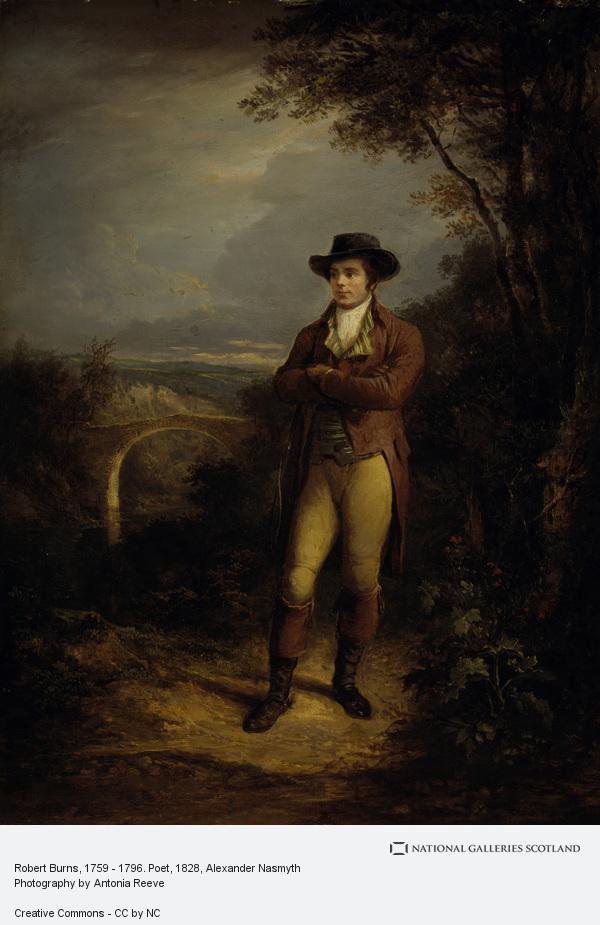


25th January marks the annual celebration of Burns Night - a time to celebrate Scotland's favourite son, and world renowned poet and song writer Robert Burns who was born on this day 1759.
I have covered Oor Rabbie on may occasions so on this day I hope to bring you a few facts about Scotland's National Bard and his legacy.
Known as somewhat of a ladies man, Burns is known to have fathered 12 or 13 children, depending on the source, to 4 different women. His last born child, Maxwell, was born on the same day as his funeral 25 July 1796, meaning his wife Jean Armour missed his send off.
As a lad growing up in Ayrshire, Burns was always fond of supernatural stories, most of which were told to him by an old widow who helped out on his father's farm. These stories no doubt had an influence on his writings in the future and perhaps were the inspiration for his classic masterpiece, Tam O'Shanter and the lesser known Adress to the Deil and Halloween. Even in these poems he flattered the fairer sex with his words, this from the latter poem.....
The lasses feat, an' cleanly neat, Mair braw than when they're fine; Their faces blythe, fu' sweetly kythe, Hearts leal, an' warm, an' kin':
Of course Burns also gives another of his favourite subjects a mention in this verse, "the deil himsel," Look it up it's another guid yin!
Burns didn't always want to stay in Scotland - he hoped to move to the Caribbean island of Jamaica. Although following the success of his poetry collection 'Poems, Chiefly in the Scottish Dialect' (or the Kilmarnock Edition as it is known), he opted to move closer to home, settling in Edinburgh for a time.
For all his fame, Burns never forgot his humble roots. His love for farming stayed with him throughout his life and his writing often dealt with issues affecting the poorer classes, notably highlighting the need for greater social equality. Indeed he is known as the Ploughman Poet, a nod to his farming life.
And on his legacy, Burns has gathered some very famous fans since his passing, US president Abraham Lincoln could recite Burns’ works by heart. Bob Dylan says that ‘A Red, Red Rose’ by Burns is his source of greatest creative inspiration and Michael Jackson song Thriller is said to have been inspired by Tam O'Shanter.
In Japan at pedestrian crossing you don't get beeps like here in Scotland, they play a rendition of the Burns song ‘Coming Through The Rye’.
There are more statues in honour of Rabbie than any other male figure in history, only surpassed in total by Queen Victoria. (I am not including religious statues).
In 2005 Robert Burns was the first person ever to feature on a bottle of Coca Cola, about a million were made they currently trade for around £10 and I have one, unopened in my kitchen cupboard.
Arguably Burns most famous song, Auld Lang Syne, has appeared in over 170 Hollywood films including The Apartment, It’s A Wonderful Life and When Harry Met Sally. , but he only rewrote the verse, he sent the poem to the Scots Musical Museum in 1788 indicating that it was an ancient song but that he'd been the first to record it on paper. The phrase 'auld lang syne' roughly translates as 'for old times' sake', and the song is all about preserving old friendships and looking back over the events of the year.
In the US city of Atlanta, there is a life-size imitation of Burns’ first home in Alloway, South Ayrshire, although it doesn't have the famous thatched roof.
In Scotland, there are some 20 official Burns memorials dotted around the country, from Aberdeen to the final resting place of Burns in Dumfries, which commemorate his journey from Ayrshire to “Auld Lang Syne”.
‘My Heart’s in the Highlands’ was translated and adopted as the marching song of the Chinese resistance fighter in the Second World War.
In 2009 STV viewers voted Robert Burns ‘The Great Scot’, beating the likes of William Wallace, Robert the Bruce among others.
There are Burns Clubs scattered across the globe, but the very first one, known as The Mother's Club, was founded in Greenock in 1801. They held the very first Burns Supper on what they thought was his birthday, January 29th 1802, only to discover that his birthday was actually January 25th!
Since then Burns suppers have been held worldwide.
I know some of you out there will toil to understand some of Burns's poetry, don't fear you will find the Best of Robert Burns, translated into the "de'il's tongue" just Click here...
The song Ae Fond Kiss, was one of my mums favourites the words "Never met-or never parted, We had ne'er been broken-hearted" are inscribed on her grave......"
43 notes
·
View notes
Text
I'd be great at violence and other crimes, I'd like to think. If that was a job, I mean.
Unfortunately the legal jobs that get characterized often as being "violence and crimes as a job" contain very little violence and crimes by weight and also have a degree of forced conformity that I don't think I'd do well with. So I guess we'll never know if I'd be good at them.
The point is I think museums should legally be able to assemble heist teams to heist other museums's shit. This could solve essentially no problems, create many new ones, and destroy a bunch of priceless artifacts, but also it would be very funny and those priceless artifacts were stupid anyway.
In fact I think museums should all be allowed to steal anything from anywhere if they can get away with it, and it should be very easy to legally become a museum, with the main conditions being you can't sell your collection and have to display some percentage (maybe 5 or 10%?) of it where it can be seen by the public (for at most a small fee, maybe like $20 tops). Heist wars. "Come to the Guggenheim, we stole davinci's older, better woman-with-an-emotion painting and threw the Mona Lisa in the trash like the trash it is." "Welcome to the National Museum of Brazil, featuring three insects and a bust from the British museum, one of the Benin Bronzes, the liberty bell, Two Thirds of Bill Paldorski from the US's vinyl collection, and a terracotta soldier replica we made because the one we had got heisted by the Museum of Gabon. Also some stuff from Brazil, but you're not here for that." "Welcome to the Monument Museum. We were founded three years ago specifically to display the Statue of Liberty, and six days ago, as you may have heard, we successfully heisted it. It will be available for public viewing after we've reassembled it. In the meantime check out our Battle of May Island memorial stone and Minaret of Sinan Pasha Mosque, both of which we heisted for practice"
This would clearly be a superior world to live in.
18 notes
·
View notes
Text
The Price of Peace
Before the war, Hiroshima was a sizable city known for its castle town were on par with Himeji or Osaka Castle. During the war, it became a focal point of military activity with large depots of military supplies. Not too far away was the location for where the Akatsuki Corps, a special cadet system set up by the Army as the war situation grew more severe. These young men were trained daily in preparation for suicide attacks against the Allied Forces.
Everything changed, however, on 6th August 1945 when the United States of America dropped the 'Little Boy' atomic bomb and killed approximately a hundred thousand people in the blast, and upending thousands more in the intervening years.
With this one mighty blow, the death knell of World War II was rung with the Allied Forces anointed the winners.
But what was the price for this victory?
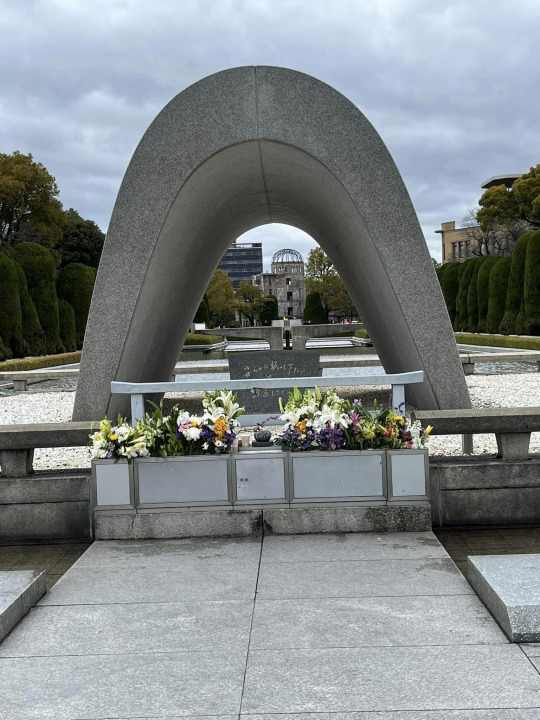
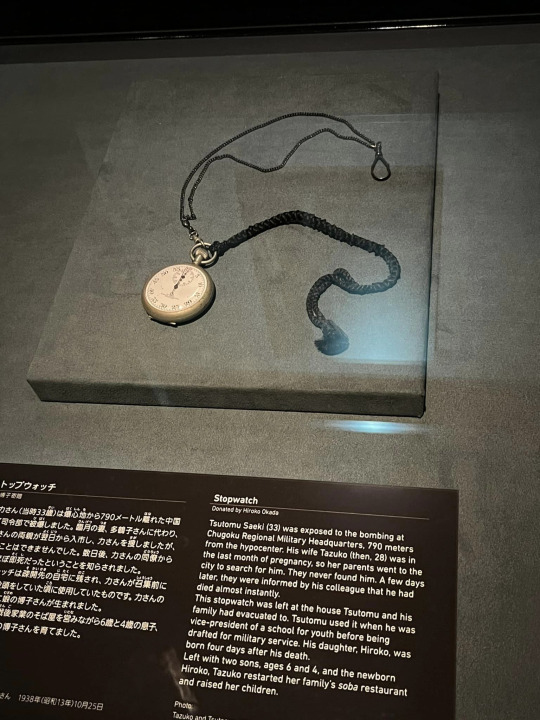
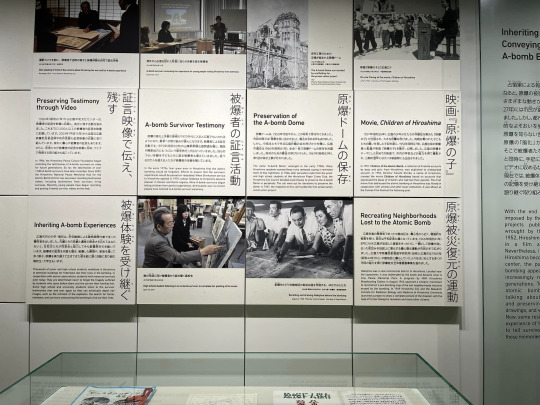
As the film Oppenheimer opined, perhaps the creation of the atomic bomb had ignited the world into a downward spiral to destruction. Humanity was so beholden with the idea of if they 'could' create such a bomb there was too little consideration on whether we 'should.' War is tribalism at its best, where we paint those like us as the 'good guys' and demonise the opposing side.
We might all be humans struggling to live on this planet we call home but should someone come to disrupt the equilibrium we live in, humans are very quick to lash out and attack those they feel are too 'different.' In societies of old, blame was laid on 'outsiders' for all manners of ills. The witch hunts are one such example.
In any case, the creation of the atomic bomb led to several more weapons of mass destruction being constructed as a means to threaten and deter others despite attempts from the survivors to prevent their proliferation. A macrocosm of a race to have the bigger weapon or to 'protect' one's interest because you see the neighbour across the street has bought a gun.
As an aside, America's gun laws are a mess and if the world ever needs to see what stocking weapons of mass destruction could lead to, look no further than the mass shootings in America that happen almost every day.
It only takes one imbecile (or, in the case of nuclear weapons, a nation of imbeciles) to plunge the world into disrepair.
Anyways, what I wanted to say was that listening to the testimonies and reading the stories of those who lived through the endless days of Hell after the atomic bomb, it became very hard for me to reconcile why anyone would want to keep nuclear weapons on hand. The pain and death it caused. The aftereffects due to radiation. And the shattering effect it had on families as they grappled with their loss.
No dispute, be it over bruised pride or resources, should ever need the use of nuclear weapons for the victory attained would be Pyrrhic at best. Even the Akatsuki Corps members, boys who were trained to give up their lives in service to their nation, could not equate the destruction of HIroshima with 'glorious' war.
This was all laid bare to me at the Atomic Bomb Museum and the Hiroshima National Peace Memorial Hall for the Atomic Bomb Victims.

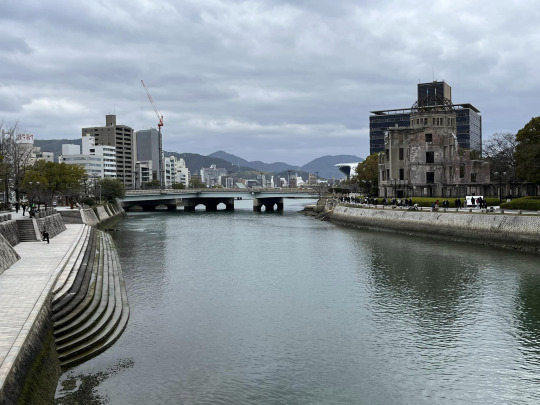

Now, I'm not sure how telling it is but while Hiroshima had a large number of peace tourists visiting the cenotaph and the Atomic Bomb museum, there hadn't been as many visitors to Nagasaki. Rather, Nagasaki had more local tourists flocking to the region wishing to try out specialty dishes such as champon noodles and castella.
After appreciating the gravity of the events that shaped modern Japan, including the Atomic Bomb Dome, bleachpanda and I enjoyed a very noodle-heavy okonomiyaki at a nearby restaurant before we headed to Hiroshima Castle.
Hiroshima Castle was established by Mori Terumoto in 1589 at the delta of the Otagawa River. In 1600, following the battle of Sekigahara, Terumoto was forced to retreat and Fukushima Masanori from Kiyosu took control of the castle. However, after restoring the castle following the flood of 1619 without permission from the Tokugawa shogunate, Masanori was dismissed. Asano Nagaakira then became lord of Aki and the Asano family continued to hold this position up until the Meiji restoration.
Inside Hiroshima Castle, we climbed, reading about its history from the exhibits until we managed to reach the top and looked out on the city. After seeing the tragedy of the atomic bomb, it was nice to learn some of Hiroshima's early history as a bustling city and its ties to the Tokugawa Shogunate before its abolition.
Despite the cloudy day, Hiroshima glimmered before us int he afternoon light.
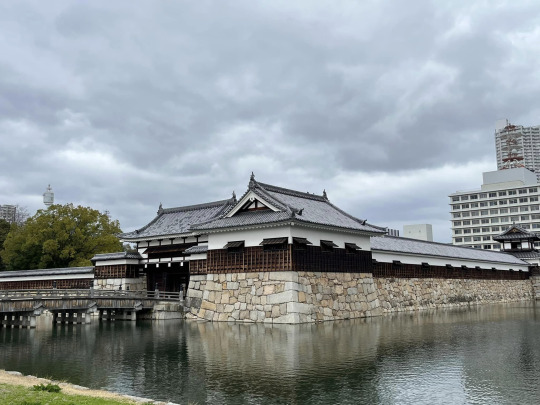
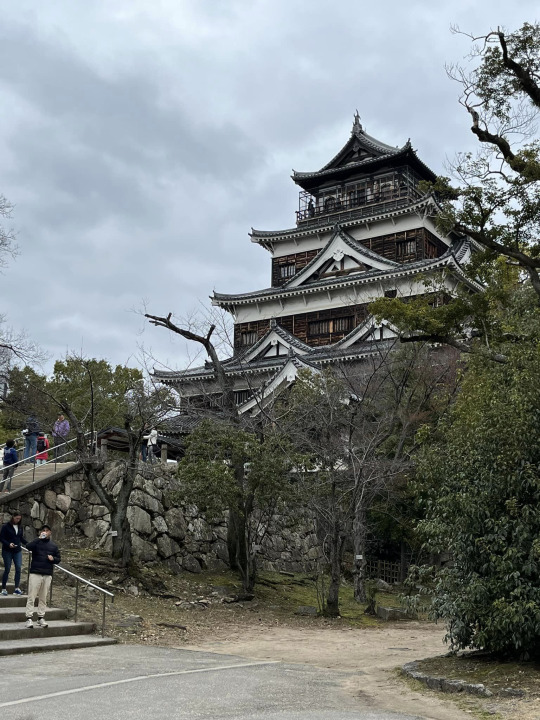

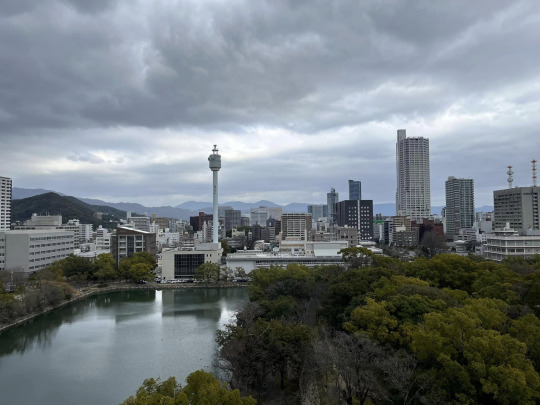

Our key tourist sites finished, bleachpanda dragged me to Animate - a weeb store filled with gacha capsules on the ground floor with figurines (including Ichiban Kuji prizes), mang, doujinshi and other merchandise from popular anime available for purchase.
While I picked out some tasteful Detective Conan acrylic stands, bleachpanda ended up buying a Demonslayer shirt that cost more than half of my purchase! Truly, she is a fiend who cannot be stopped. And will then turn around the next moment to blame an innocent, such as myself, for her extravagant spending!
As the day drew to a close, bleachpanda and I ended the day at Sensui, a restaurant at the Hilton. The two of us got the Onomichi set (a place I would have liked to visit because Yakuza 6: The Song of Life had its early story beat set here. And it is where we get the mascot Ono Michio! With his charming hassaku face, steamy Onomichi ramen hat, cute fish pouch and cool boots, vital for any fisherman, and his cool and trendy Ono shirt!) and which cost us approximately 100,000 yen each!
Given half our holiday was over anyways, i thought it a nice touch to splurge a little and treat ourselves. Tomorrow, after all, was another day of transit as we headed further east to Osaka. And while I wouldn't be able to see the sights of Miyajima or Onomichi, I did have one thing I was excited for.
Universal Studios Japan, here we come!
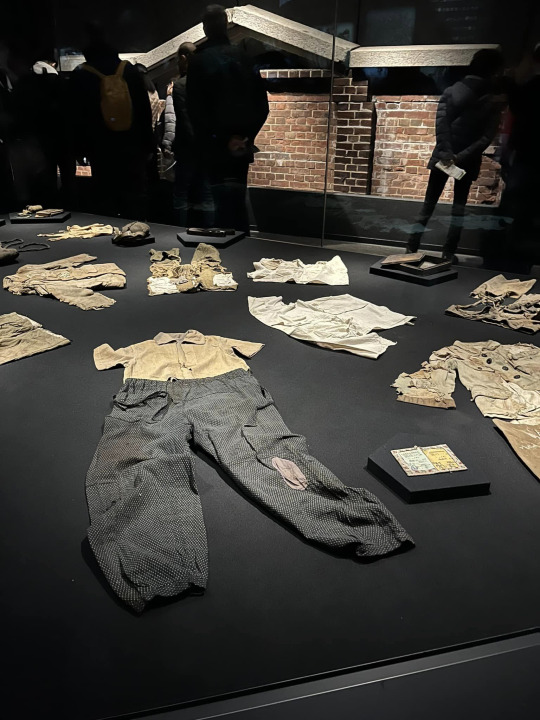
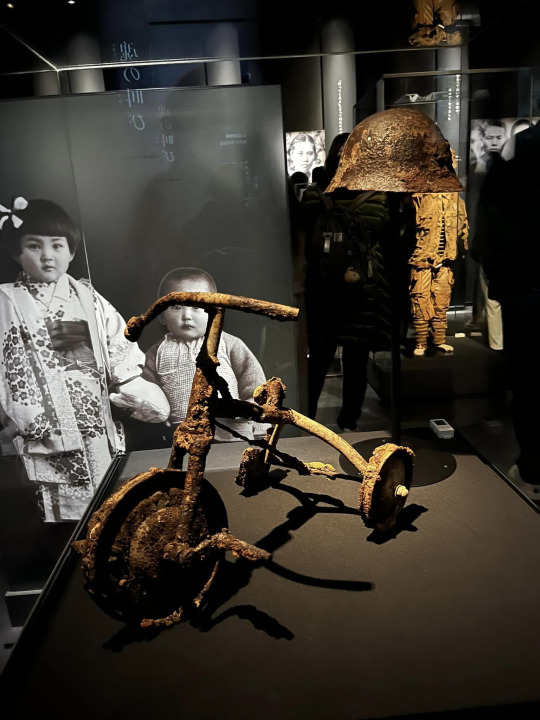
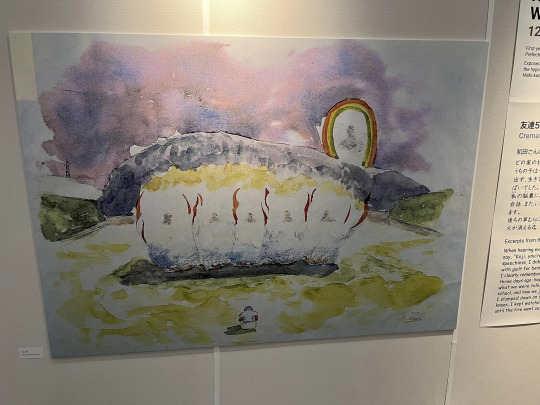
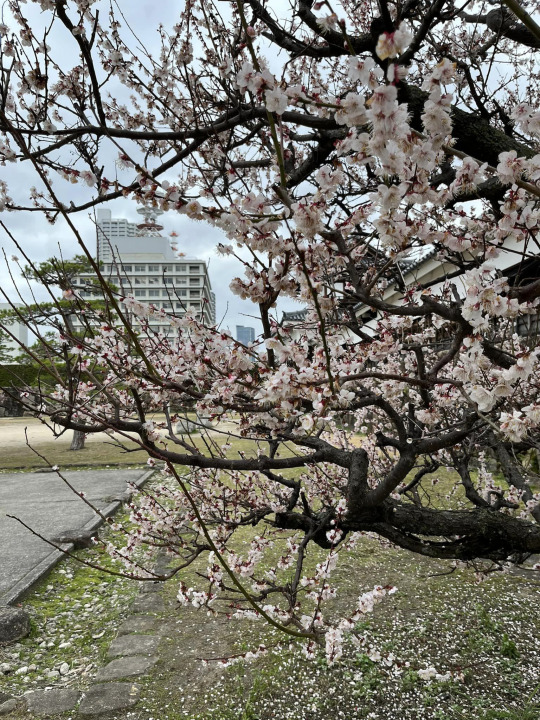
#personal blog#travelling#travel blog#hiroshima#atomic bomb museum#peace memorial hall#hiroshima castle#animate
13 notes
·
View notes
Text
Daily update post:
The IDF confirmed that yesterday's barrage of rockets at Tel Aviv and its vicinity was fired out of a zone that it defined as "humanitairan" (meaning an area it encouraged civilians to evacuate to).
We're seeing more and more Palestinians who speak up against Hamas. In the past (even during this war), Al-Jazeera "journalists" cut off Gazans who were criticizng Hamas. Now we have a small shift, where this journalist is still trying to persuade this woman not to criticize Hamas, but he doesn't cut her off as she insists on expressing her anger, that all of the aid to Gazans is being stolen by Hamas terrorists:
After a battle with terrorists inside a UN school in the neighborhood of Shujayiah in Gaza, IDF soldiers documented finding weapons hidden inside a teddy bear (first vid in this article).
As you might remember, I work at Yad Vashem, Israel's national Holocaust museum, research and education center, which also studies Jewish history in general, a subject that obviously includes the history of antisemitism. However, the scope of the history we covered always stopped roughly at when the last Jewish Holocaust survivor left the last DP (displaced persons) camp, which is 1956. The assumption was always that we will research historical antisemitism, and people will be able to take that knowledge, learn from it, and apply it to current ("new") antisemitism, without us tackling it directly. Following the biggest massacre of Jews since the Holocaust, the global rise in amtisemitic attacks in reaction to it, and the academic rot we have witnessed in dealing with antisemitism on the campuses of some of the most important universities in the world, this is going to change. YV will expand the work of our research institute into new antisemitism (anti-Zionism, really).
Yesterday, three Hezbollah terrorists were killed in a strike in Syria. You absolutely should be asking yourself why Hezbollah, a terrorist organization that claims to be the "defender of Lebanon," had a unit operating in Syria. Just a reminder: there have been rockets fired at Israel from Syria.
Another thing that happened yesterday, is that we got confirmation Hamas is also using female terrorists. So when you hear, "This is the number of children killed! This is the number of women killed!" (beyond a healthy suspicision we should all have of the uncorroborated figures provided by a terrorist organization), remember that Hamas uses teenagers and women as terrorists, not just as human shields. And it will NEVER report them as such. It barely recognizes that any terrorists were killed in this war, even though independent estimates indicate that "above 5,000 terrorists" is the most conservative estimate on this matter.
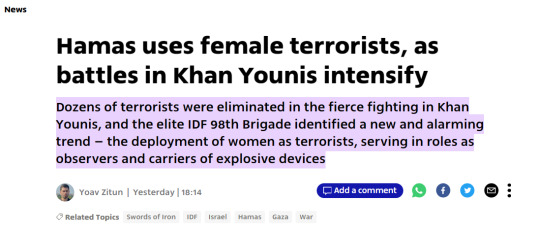
Unlike Hamas, which doesn't admit when women fight and die for it, Israel is proud of its female fighters. Here's a vid about a group of soldiers who made history on Oct 7, being the first female tankists in the world to fight in an armored battle.
youtube
This is 25 years old Sahar Baruch.
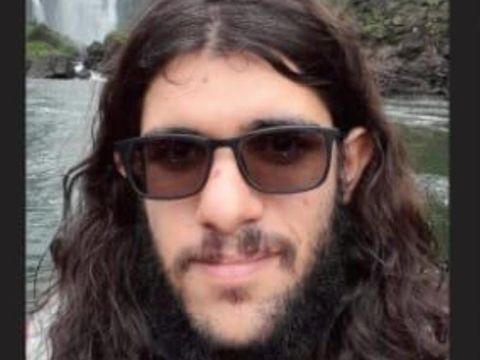
On Oct 7, he was kidnapped to Gaza. Hamas has published a vid that first showed sahar captured, and then showed his lifeless and bloodied body, indicating that he was murdered in captivity. May his memory be a blessing.
(for all of my updates and ask replies regarding Israel, click here)
#israel#antisemitism#israeli#israel news#israel under attack#israel under fire#israelunderattack#terrorism#anti terrorism#hamas#antisemitic#antisemites#jews#jew#judaism#jumblr#frumblr#jewish#Youtube
112 notes
·
View notes
Text
I'll start at the beginning.
There was a divergence of events involving Rock in the Classic saga. During a conflict, he hit his head, and his programming was completely altered, giving him homicidal tendencies and an ever-growing desire to kill Wily. One day, the inevitable happens: Wily dies at the hands of an out-of-control Mega Man, who is subsequently killed by Bass.
Things go downhill from there: Bass is deactivated after killing Megaman, Roll couldn't deal with Rock's death and got deactivated too, society's perception of robots changes (as the first law of robotics is broken), and Dr. Light has to face the consequences of an old friend being killed and one of his creations going berserk. Dr. Light repurposes what remains of Rock’s body to create X, hoping that when he awakens, he can atone for the sins of his past and become a new hero—though still fearing that history might repeat itself.
Light dies some time later, and his daughter takes over the project’s completion. During a Japanese-American war, Protoman helps Japan find a way to end the war diplomatically. Later, he requested to be deactivated and placed in a museum as a memorial to their successful attempt at changing people’s perceptions of robots once more.
After the war, Japan regains its status as a first-world nation, thus beginning the X saga.
There might be a few plot holes here and there, but I’m not too concerned. Over time, I’ll make changes. I hope you guys liked the idea!
#megaman#megaman x#megaman x rewrite#rewrite#megaman classic#am i doing this right#idk if people are going to be interested#but here we are
3 notes
·
View notes
Text
Noah Berlatsky at Everything Is Horrible:
In the Anglophone world, the intertwined issues of Jewish identity and antisemitism are connected in public memory obsessively, and almost solely, to the Holocaust. Occasionally, perhaps, people also mention the blood libels of the Middle Ages, or the pogroms of Eastern Europe.
The Dreyfus Affair, however, is almost entirely forgotten. It is not a moment revisited in movies or television shows. Politicians do not reference it; there are no public museums in its memory; it is not a part of school curriculum. Even Jewish people hardly discuss it. I doubt one in ten Americans, of any ethnicity or religion, could even tell you vaguely who Alfred Dreyfus was. The disappearance of Dreyfus memory is a real loss. That’s not because we need to remember antisemitism. We do, as I’ve mentioned, remember the Holocaust. The Dreyfus Affair, though, was a victory over antisemitism, and a victory particularly for the diaspora, in a way that World War II was not. The Holocaust has largely been interpreted as an object lesson in the untenability of the diaspora, and the necessity of a Zionist Jewish ethnonationalism. The outcome of Dreyfus’ story is considerably more ambivalent. As such, it is worth revisiting at a moment when Zionism is busily and horrifically delegitimizing itself.
The Affair
Since, the outlines of the Dreyfus Affair are probably little known to readers, it’s worth covering them briefly. My discussion here, and throughout the essay, is mostly based on Maurice Samuels new excellent biography/history, Alfred Dreyfus: The Man At the Center of the Affair, part of the Jewish Lives series. During the French Revolution, France put into practice its new ideals of liberty and equality by, among other things, making Jewish people full citizens of the republic. After legislation in 1791, Jews were suddenly—for the first time in any European country—able to live where they wished, attend the best schools, and work in every profession. The results were immediate and dramatic. Jews made rapid gains in political and economic life; some became quite wealthy and influential.
Among those wealthy Jews was the Dreyfus family. Alfred Dreyfus, born 1859, grew up, like most French Jews, with a passionate commitment to the French nation and to the principles of equality which had liberated them. Determined to serve his country, Dreyfus attended the French military academy. He excelled and became arguably the first Jewish officer ever on the General Staff. His future seemed bright. And then, it all fell apart. In 1894, the French army discovered that there was a traitor on the General Staff who had been passing top secret information to the Germans. Dreyfus was accused of treason. The evidence against him was weak to nonexistent; his handwriting was said to match that on the recovered documents, even though it obviously did not. Nonetheless, he was arrested, tried in a sham military trial, and sentenced to life imprisonment. He was sent to the horrific penal colony on Devil’s Island in French Guiana. He endured tortures almost certainly intended to kill him. His wife, contrary to law, was not allowed to accompany him. Dreyfus was singled out because he was Jewish. The generals, once they had begun down the path of antisemitism, decided they could not turn back without undermining respect for the military. They forged more evidence, and stonewalled investigations as long as possible.
The Affair polarized sentiment in France, both on Dreyfus and on the place of Jews in French society. Liberal intellectuals like Émile Zola who believed in the Republic and a forward-looking, cosmopolitan, free and equal France sided with Dreyfus and demanded a new trial. The Catholic Church, the military, antisemites, and proto-Vichyites insisted that Dreyfus was guilty and should be punished—or, really, insisted that as a Jew he should be punished whether he was guilty or not. The hatred of Jews erupted into antisemitic riots throughout the country; Jews were beaten, their homes burned, their businesses destroyed. Several Jewish people were killed in Algiers, where there were violence against Jews occurred almost daily in 1898. Dreyfus was brought back for a new trial in 1899; he was convicted again despite overwhelming evidence in his favor, and eventually exonerated completely in 1906. He was restored to the rank of Major, and served with distinction in World War I. He died in 1935. Jewish people in France still leave stones on his grave.
[...] It wasn’t just Dreyfus and Jewish people who fought for Dreyfus though. The Affair energized every corner of the left, calling them almost uniformly to their best selves. Zola, for example, believed in a number of antisemitic stereotypes at the beginning of the Affair; his first article on the case argued that Jewish people had an innate talent for making money. From that inauspicious beginning he quickly became one of the most passionate gentile opponents of antisemitism in history; his famous 1898 pamphlet J’accuse was a devastating denunciation of the military coverup intended to force a number of generals to sue for libel. They did, and Zola was forced to flee the country—but not before opening the case again and ensuring Dreyfus’ retrial.
The political left in France was also, initially, wary of standing with Dreyfus because of antisemitism. For many socialists, Jewish people symbolized the banking industry and the upper class. Dreyfus, a wealthy Jew serving in the military, seemed the wrong man to rally working class parties. But eventually Socialist leader Jean Jaurès, and others in his party, recognized that Dreyfus had become the man, and the issue, on which Catholic monarchist and capitalist forces had decided to fight for France’s soul. In 1898 Jaurès gave a speech in which he denounced antisemitism as a threat to France; shortly thereafter he published a book defending Dreyfus and presenting the Affair as a matter of socialist solidarity. Some on the left refused to join Jaurès, and the Socialists split. But as Samuels’ biography of Dreyfus notes, “Jaurès helped ensure that a large part of the political left in France would align itself with republican values and against antisemitism for decades to come.”
Noah Berlatsky wrote in his Everything Is Horrible Substack about how the Dreyfus Affair served as a victory against fascism and antisemitism, and how it gave the left a tool to fight back against oppression.
#Dreyfus Affair#World History#Judaism#Zionism#Antisemitism#France#Alfred Dreyfus#Émile Zola#Jean Jaurès#Noah Berlatsky#Europe
8 notes
·
View notes